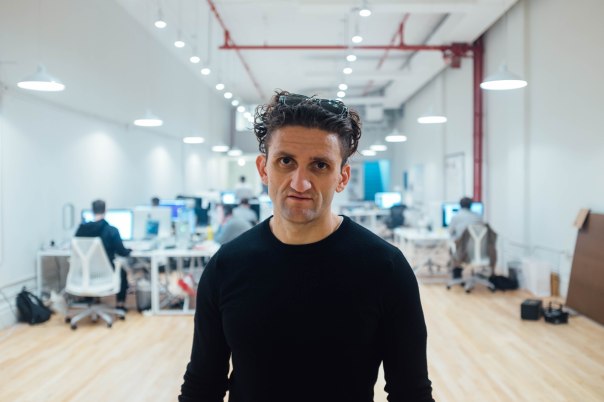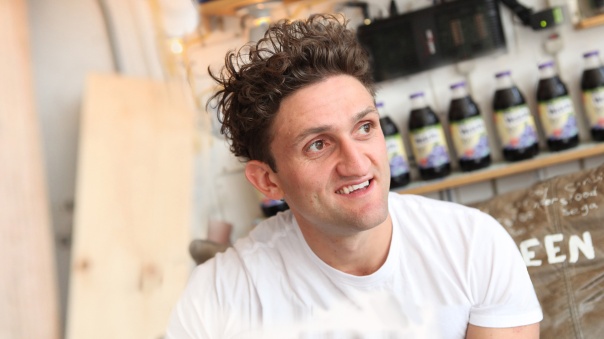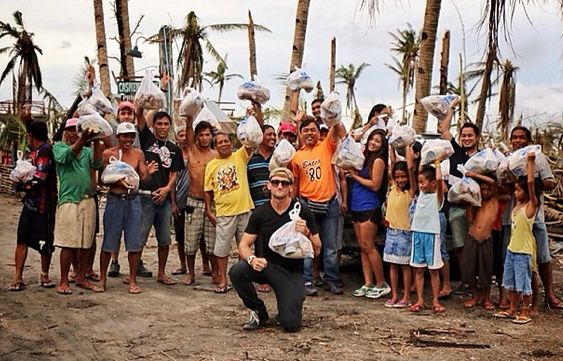By Eilish Massie (n9483527)
The great debate between journalists and bloggers has been a long withstanding argument in the media, with many journalists stating bloggers are not journalists. With the changing media environment and print media’s downfall, journalists have no choice but transfer to online journalism as their news platform. The following is a background report about whether aspiring journalists should turn to blogging, and if bloggers are considered journalists within the media.
THE DOWNFALL OF PRINT MEDIA HAS LED MORE JOURNALISTS ONLINE
It is no secret the downfall of print media is on its way out resulting in more journalists losing jobs in traditional media. Journalists are finding the shift in traditional media much harder to adapt to the changing media landscape. With job cuts reported in Fairfax Media earlier this year, more than 120 editorial jobs were lost, which resulted in Fairfax staff to ‘take a stand in solidarity’1. The decline of the newspaper industry has felt vast repercussions due to the transition to digital media.
As reported by statista.com2, ‘while the number of subscribers and overall circulation has always been important for newspaper publishers, for much of their history they have been supported primarily through their advertising revenues and despite increasing trends overall, they have largely been unable to capitalize on the continued ad spend growth’.
QUT STUDENTS SHARE THEIR THOUGHTS ON DIGITAL JOURNALISM
As reported by ABC News1, the Fairfax cuts was ‘necessary to sustain high quality of journalism’. In a statement to the ABC, Fairfax Media CEO Greg Hywood said ‘in an ever-changing highly competitive media environment which involves rapid evolution of our publishing model. The initiatives we have proposed today are part of adaptation and are necessary to sustain high-quality journalism”.
Ultimately, the decline in traditional media has resulted in more journalists using digital media, such as social media as their main source of news. Additionally, with more journalists choosing digital media, statistics show the added growth has journalists seeking further training. This is in order to keep up to date with the changing media landscape. In a statistic from Statisa.com4, it shows 30% of journalists are seeking video and editing training within the industry, with 28% of journalists requesting education on social media engagement.
Social Media has increasingly expanded over all mediums of news sharing platforms. As social media continues to consume daily life, it is only natural for digital journalism to adapt to this new medium of sharing. However, with this change of social media arises the ideology social media makes news unreliable. In a 2013 report5, it is revealed 51% of PR professionals worldwide believe social media has made news less reliable as journalists do less or no fact checking.
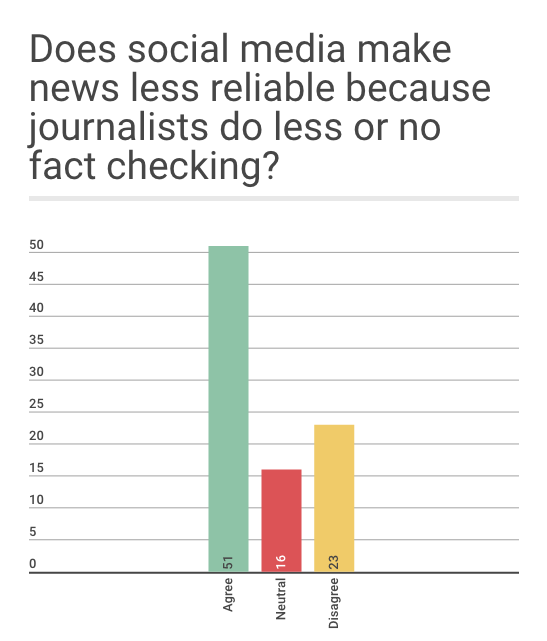
Data provided by © Stastisa 2016 | Graph Visualisation by Infogram
This belief coincides with the idea bloggers are unprofessional, and according to Jolie O’Dell, bloggers are not considered journalists as they are based on opinion rather than fact. This calls in the question about whether or not, bloggers are deemed unreliable in the media.
ARE BLOGGERS UNRELIABLE- ACCORDING TO JOURNALISTS
Bloggers have reaped controversial attention, particularly from other journalists in the media. The Next Web6 [TNW] states, “In the earliest days of blogging, even the best blogs incorporated a good deal of opinion and were relatively light on actual journalism”. As mentioned above, the belief about the unreliability of bloggers has transferred into today’s media landscape with majority news outlets believing bloggers are rather opinionated, and do not provide factual evidence in their content. According to TNW6, due to the easy access of social media and publishing websites, the result is a large inconsistency in the standards of blog posts, especially those written by bloggers with no journalistic background.
Journalists such as Jolie O’Dell7, Ryan Young8 and Michael Poh9 state there are fundamental differences to distinguish a blogger from a journalist. According to Ryan Young, a journalist must know new, essential and interesting information. All information must be contributed to fact and not fiction. O’Dell states a journalist’s role in media is to ultimately serve the people, while “the blogger serves himself first and has no real social imperative in most cases”, whilst Poh states journalistic blogger’s role is to communicate ideas to your audience.’
To Summarise, O’Dell, Young and Poh view journalists as practitioners in their own right, as journalism requires certain skill-sets. Though, they believe bloggers are not journalists, as they have no training in the industry. Furthermore, TNW6 states ‘those who draw sharp distinctions between blogging and journalism are correct in asserting much of the blogging world has little interest in proper journalism. However, TNW also states ‘the blogging world can be used as training ground for future journalists’.
(https://www.youtube.com/watch?v=q4JGX_–3uw)10
Fundamentally, the rise of social media has led upcoming journalists to utilize blogging to further their skill-sets for future endeavours. Students in university are taught and encouraged to network, and to start utilizing their skills by writing in their own blogs. As mentioned previously, journalists from the United States in 2013 were asked what type of training was most desired by journalists. It was reported 30 per cent of journalists wanted further training in video editing, whilst 28 per cent wanted training in social media engagement4, clearly indicating the shift to digital journalism has led more journalists to engage online socially.
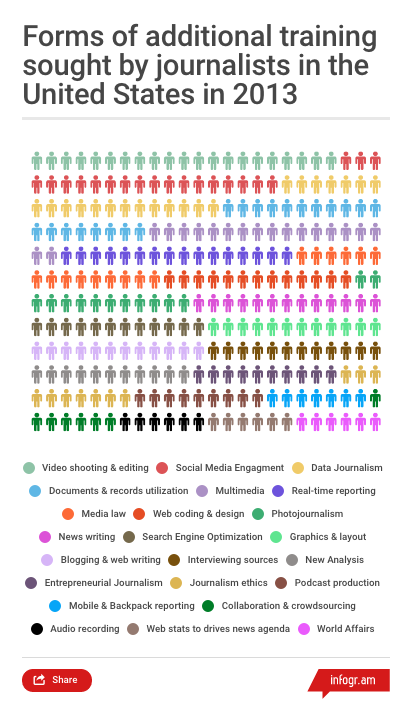
Data provided by © Stastisa 2016 | Graph Visualisation by Infogram
(https://infogr.am/app/#/preview/f464ed80-aef0-4fba-8f5d-0a026374d321)
According to Martin Bryant11, journalism comes down to ethics. Journalism “boils down to ethical, original reporting that respects the reader and tells them something new. It’s worth noting as well many so-called professional journalists have more in common with casual bloggers than anything”. Journalists are trained in ethics. Under the Media Entertainment and Arts Alliance Australian Journalists’ Association12 [AJA], journalists must have “respect for truth and the public’s right to know are overriding principles for all journalists”. Essentially, the AJA guidelines indicate the differences between a blogger and journalist, as a journalist must follow this code of ethics whereas a blogger does not have to follow any code.
In summary, blogging has allowed aspiring journalists to learn the necessary skills to become journalists. It has allowed bloggers to organise arguments, form coherent ideas and how to research concepts. Nevertheless, with no guidelines, there are no obligations for bloggers to follow any rules. Thus, indicating the fundamental difference between a journalist and blogger. Conversely, according to the law, bloggers are considered journalists, which challenges the idea of how bloggers are seen in the media.
BLOGGERS ARE JOURNALISTS – ACCORDING TO THE LAW
According to the law in the US, bloggers are deemed as journalists. Robinson Meyer writes in The Atlantic13 about Crystal Cox, an investigative blogger who wrote a series of incensed arguments about a finance group and its partners, alleging the group of tax fraud, money laundering and other crimes. The finance group sued the blogger for alleging defamation.
Oregon district court Judge Marco Hernandez ruled most of the investigative journalists entries were nothing but opinion, thus not considered to be defamation. However, one post was considered factual and Cox was sued for $2.5 million in damages. Cox claimed her sources for the tax fraud claim were secret, and Oregon’s media shield law protected her from revealing them. Judge Hernandez decided Cox was not allegeable for the shield law.
However, the intersection of two pre-existing piece of case law, New York Times Co. v. Sullivan and Gertz v. Robert Welch, Inc. both indicate the kind of speech which qualifies as a defamation.
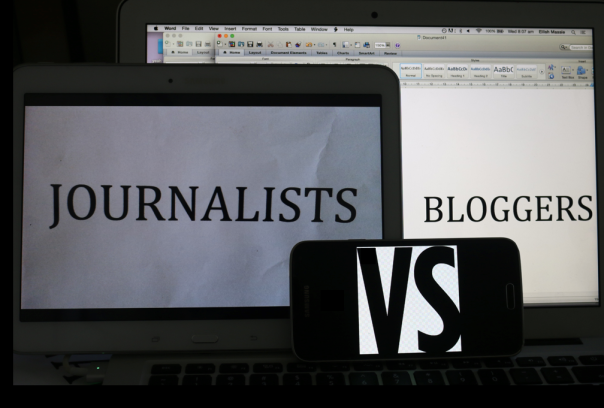
In the landmark 1964 Sullivan, Supreme Court ruled public figures can only seek claims for defamation if false information was published with ‘malice’ intention. In 1974’s Gertz, Supreme Court ruled false information about private individuals qualified as defamation if it was negligently published. Together, both cases meant false information about public figures must be published, whilst false information about private figures must be published negligently.
To Summarise, the Supreme Court did not care whether Cox was a trained journalist, but rather because the ‘lines between bloggers and journalists are blurred’. The Supreme Court states, “the advent of the Internet and the decline of print and broadcast media…the line between the media and others who wish to comment on political and social issues becomes far more blurred,” which basically states bloggers are just as equivalent to any journalist, in the eyes of the law.
In conclusion, there is little to distinguish a blogger from a journalist. A good blogger and journalist use both journalistic skills and a code of ethics in which they use in their content. TNW6 states, “a blogger may inject a little bit more analysis into a post than a journalist does in a news article, but when a blogger tracks down sources, does investigative reporting, and presents the facts clearly and fairly, that is journalism, plain and simple”. Blogging helps aspiring journalists to practice their skills, whilst it is also clear bloggers and journalists are both viewed as professionals in the media. There is no debate however, that both parties must adapt to the digital media, in order to keep up with ever-changing media environment.
Word Count: 1495
References
1 http://www.abc.net.au/news/2016-03-17/fairfax-staff-strike-in-solidarity-over-job-cuts/7254372 (Accessed 15 May 2016)
2 http://www.statista.com/statistics/183422/paid-circulation-of-us-daily-newspapers-since-1975/ (Accessed 15 May 2016)
3 Personal Interview with QUT Students conducted 22 May 2016
4 http://www.statista.com/statistics/315615/additional-training-journalism-usa/ (Accessed 18 May 2016)
5 http://www.statista.com/statistics/315907/journalists-reliable-fact-checking-social-media-worldwide/ (Accessed 18 May 2016)
6 http://thenextweb.com/us/2010/08/18/blogging-vs-journalism-the-ongoing-debate/#gref (Accessed 21 May 2016)
7 https://jolieodell.wordpress.com/2010/07/21/how-to-tell-a-journalist-from-a-blogger/ (Accessed 22 May 2016)
8 http://www.komarketingassociates.com/blog/blogging-vs-journalism-identifying-the-fundamental-differences/ (Accessed 22 May 2016)
9 http://www.hongkiat.com/blog/journalism-for-blogging/ (Accessed 22 May 2016)
10 Personal video published 24 May 2016
11 http://www.martinbryant.net/self-indulgent-post-about-journalism-and-tech-blogging/ (Accessed 24 May 2016)
12 http://www.gwb.com.au/99a/ethics.html (Accessed 24 May 2016)
13 http://www.theatlantic.com/technology/archive/2014/01/us-court-bloggers-are-journalists/283225/ (Accessed 24 May 2016)


